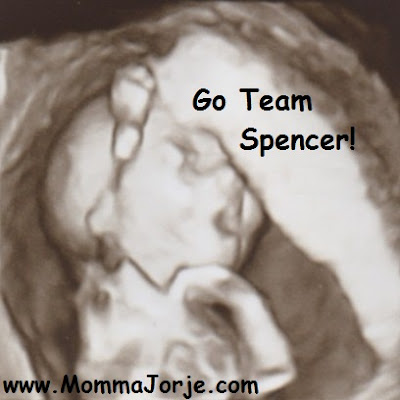To get right down to it, I'd like to start with what Down syndrome is, scientifically speaking. Humans have 23 pairs of chromosomes in every gene in their entire body. As you are surely aware, building a baby involves copying genes. Sometimes an error happens in the process.
In cases where chromosome pair #21 becomes a triplet (rather than twin chromosomes), Down syndrome is the result. The effect can vary greatly from child to child. The make-up of each chromosome is normal, but there is too much of #21. This causes an imbalance that alters the growth and development.
I've said it many times; I am very thankful that we got a diagnosis during pregnancy. I've been given the opportunity to learn as much as possible about what to expect and what health concerns we need to keep in mind.
There are some specific physical characteristics that are typically affected by "Trisomy 21" (the scientific / genetic term for Down syndrome). They are all possibilities, but do not affect every child with Down syndrome. These characteristics are:
•Low Muscle Town
•Facial Features
•Nose
•broader face (flatter mid-face)
•flatter nose bridge
•smaller nasal passages
•Eyes
•slant upward "almond eyes"
•epicanthal folds at corners
•"Brushfield spots" in colored part of iris
•small mouth
•shallow roof of mouth
•Teeth
•come in late
•come in an unusual order
•small
•unusually shaped
•out of place
•Ears
•small
•fold over at top
•small or absent ear lobes
•set slightly lower on head
•smaller ear passages
•Head Shape
•slightly smaller than normal
•back of head - flatter and shorter
•neck may appear shorter
•loose folds of skin on back of nexk
•larger soft spots (+ take longer to close)
•Stature - average weight & height, but slow growth with smaller final adult
•Hands & Feet
•smaller hands
•shorter fingers (especially the 5th finger)
•only 1 crease in palm
•gap between first and second toes
•deep crease in sole of foot in this gap
•flat feet
•unique finger and palm prints
•Chest
•funnel shaped
•pigeon chested
•Skin
•mottled
•fair
•sensitive
•Hair
•thin
•soft
•sparse
•may fall out in patches
You know when you "pass" in Scrabble and you grab all new letters? Imagine this list in that way. It is a fairly random grab bag of features that may affect a child. The most common are italicized. With the exception of low muscle tone, none of these physical characteristics will hinder a baby's health or development. There are some special health concerns for babies with Down syndrome, but I'll tackle those later in the month. Thank you for stopping by and learning a bit about Down syndrome!
What did you learn here?
Do you have any questions about Down syndrome?
 The Buddy Walk is a one-mile walk in which anyone can participate without special training. It is an inspirational and educational event that celebrates the many abilities and accomplishments of people with Down syndrome. Whether you have Down syndrome, know someone who does, or just want to show your support, come and join a Buddy Walk in your local community!
The Buddy Walk is a one-mile walk in which anyone can participate without special training. It is an inspirational and educational event that celebrates the many abilities and accomplishments of people with Down syndrome. Whether you have Down syndrome, know someone who does, or just want to show your support, come and join a Buddy Walk in your local community!Please click this image to support Team Spencer in our local Buddy Walk, happening in just over one week!!




